
‘My mind will stay there forever’
Photographers recount their battle tales from Mosul
By ANDREW KATZ
This was always going to be a bloodbath. There was perhaps no other way to wrest Iraq’s second-largest city away from Islamic State militants who, since June 2014, had dug in and built up their defenses for whenever Iraqi forces would begin the fight to take it back.
Hundreds of photographers descended on Mosul and its surroundings through almost nine months of ground warfare. For days or weeks at a time, as Iraqi forces aided by a U.S.-led coalition aerial campaign pushed toward the city and then waded into its dark heart, they shadowed soldiers to capture a level of urban combat that U.S. officials said had not been seen since World War II.
To understand that reality, TIME asked a number of photographers to select an image from their archive that particularly impacted them, and then to write about its significance. Their words have been lightly edited for clarity and brevity.
They met civilians of all ages: physically whole or maimed or wrapped for the grave in linen, joyous in liberation or silenced by what their eyes had taken in. They ran into militants and their sympathizers: groups of men who were guarded and interrogated, blindfolded, violently tossed around or worse. They stepped on the concrete and rebar that once gave shelter to families and students and ancient treasures. They found the city’s last lion.
In the days since Iraq declared victory in Mosul on July 10—even as fighting persisted in pockets of the city—the discussion pivoted toward reconstruction. A U.N. satellite assessment of the dense Old City section offered a sense of the scale: 5,536 buildings damaged or destroyed, 37% more than in a similar assessment two weeks earlier.
But before those homes and businesses are repaired or razed to make room for new ones, before the roads cratered by airstrikes are fixed and the unexploded ordnance is removed—before the city can hum like a city again—there must be reflection on the human loss in Mosul. These images offer a start.
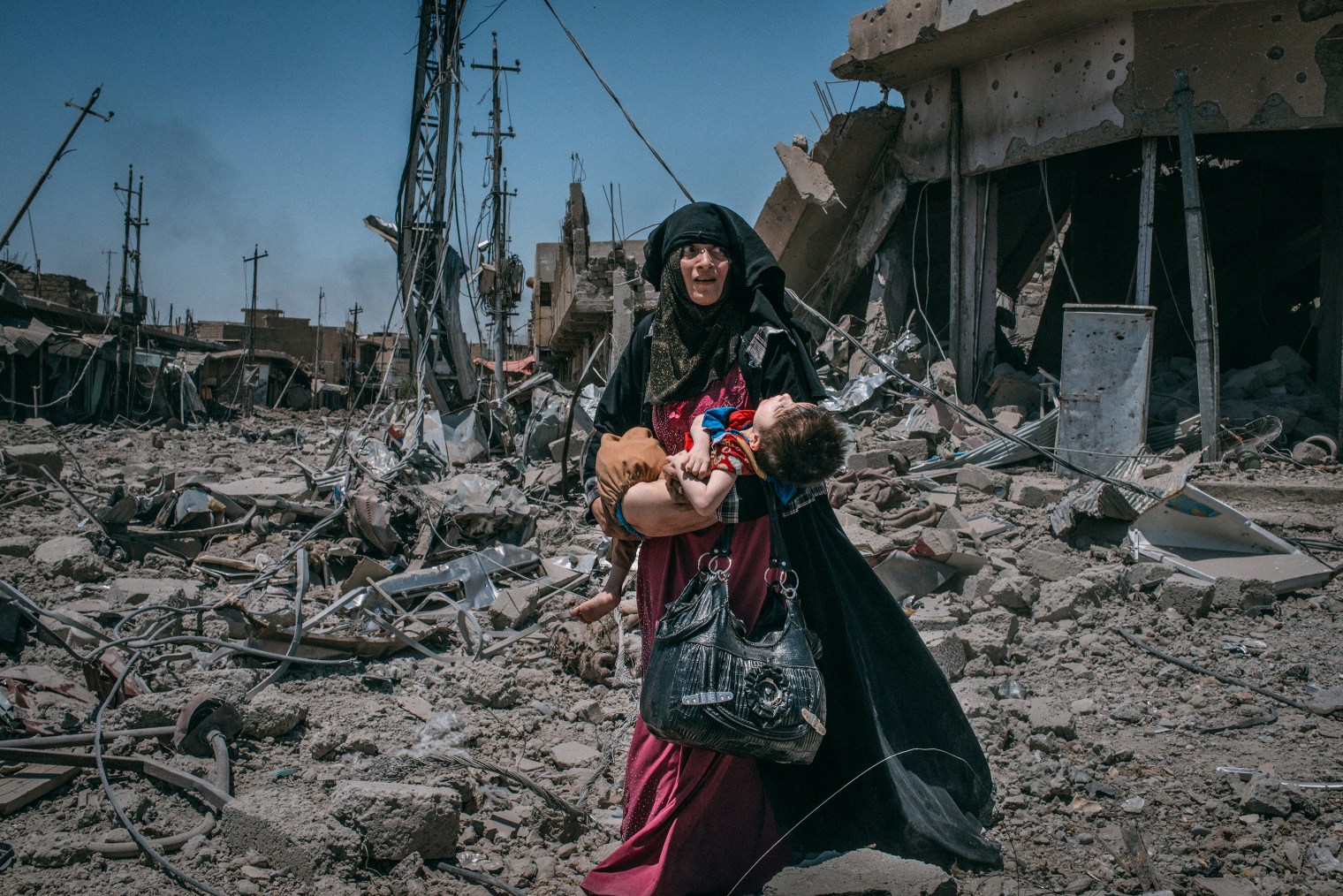 Emanuele Satolli
Emanuele Satolli
It was my fourth day embedded with Iraqi Army troops in the al-Zanjili district of western Mosul. In the morning, the soldiers tried to advance without success as Islamic State militants kept heavily resisting. At one point, maybe encouraged by the presence of the soldiers, a few civilians decided to leave their houses and began walking on a road amid the rubble.
Militants opened fire but the soldiers shot back to protect the civilians. There, I saw this woman carrying an exhausted child. She turned back toward where she came from, where the bullets were coming from, and appeared frightened. When I saw the picture again, I felt she was giving a last look at her house, her familiar road, before becoming another of the displaced.
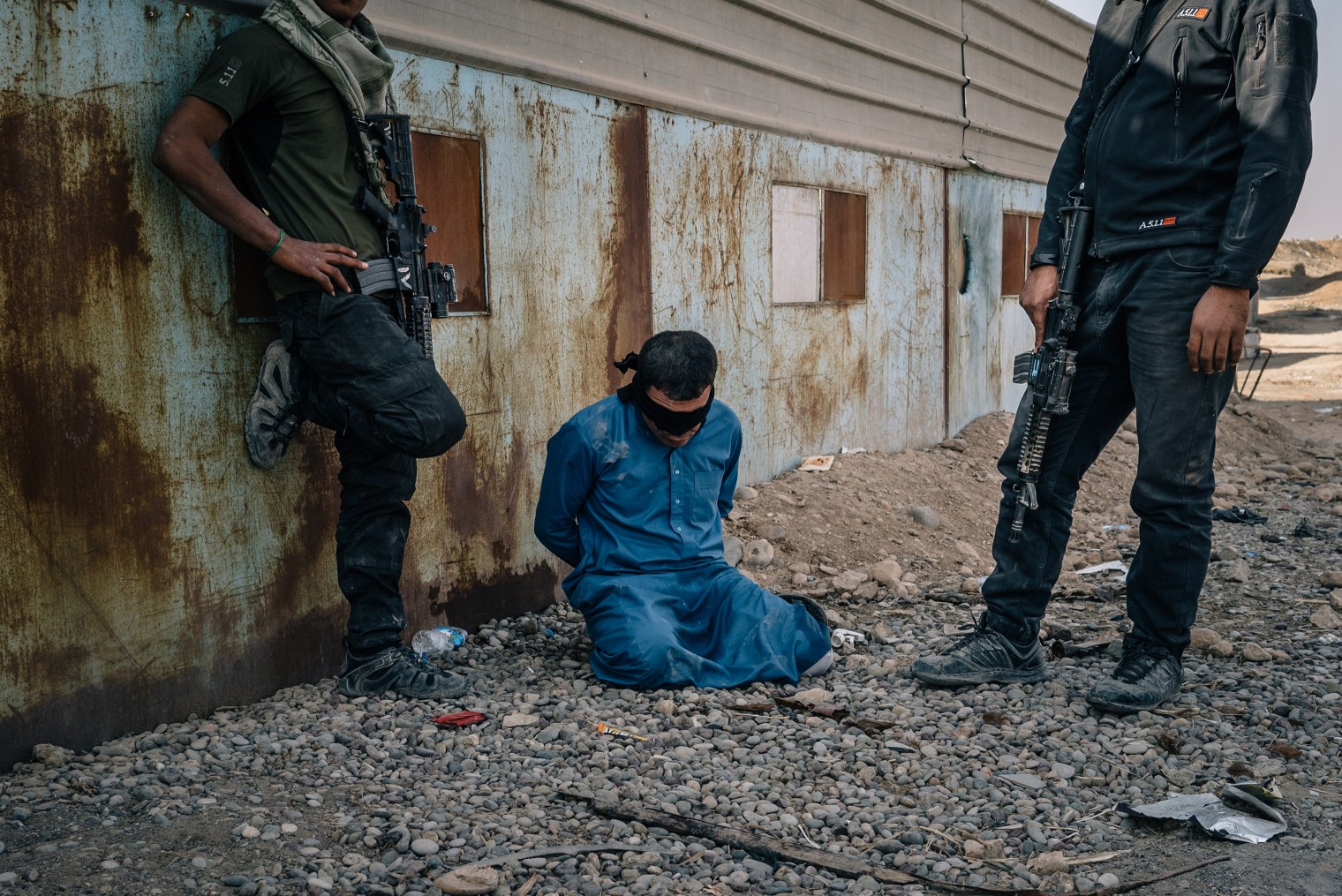 Alice Martins—The Washington Post/Getty Images
Alice Martins—The Washington Post/Getty Images
The man appeared uneasy as he approached an Iraqi special forces unit that had taken control of this Mosul neighborhood days earlier, over two years after Islamic State militants captured the city. He asked the soldiers about their positions and numbers in the area; perhaps he wanted to understand the current situation and make sure he would be safe now.
But the soldiers found his questions suspicious and accused him of spying for ISIS. When he denied it they blindfolded him, tied his hands behind his back and beat him.
As Iraq celebrates a victory in Mosul, I think of scenes like this one. A military victory over the brutal extremist group that terrorized the people they claimed to represent is an important step towards peace and security in Iraq. But even more important will be for the Iraqi government to address the grievances and distrust that encouraged some to initially welcome the militants as saviors.
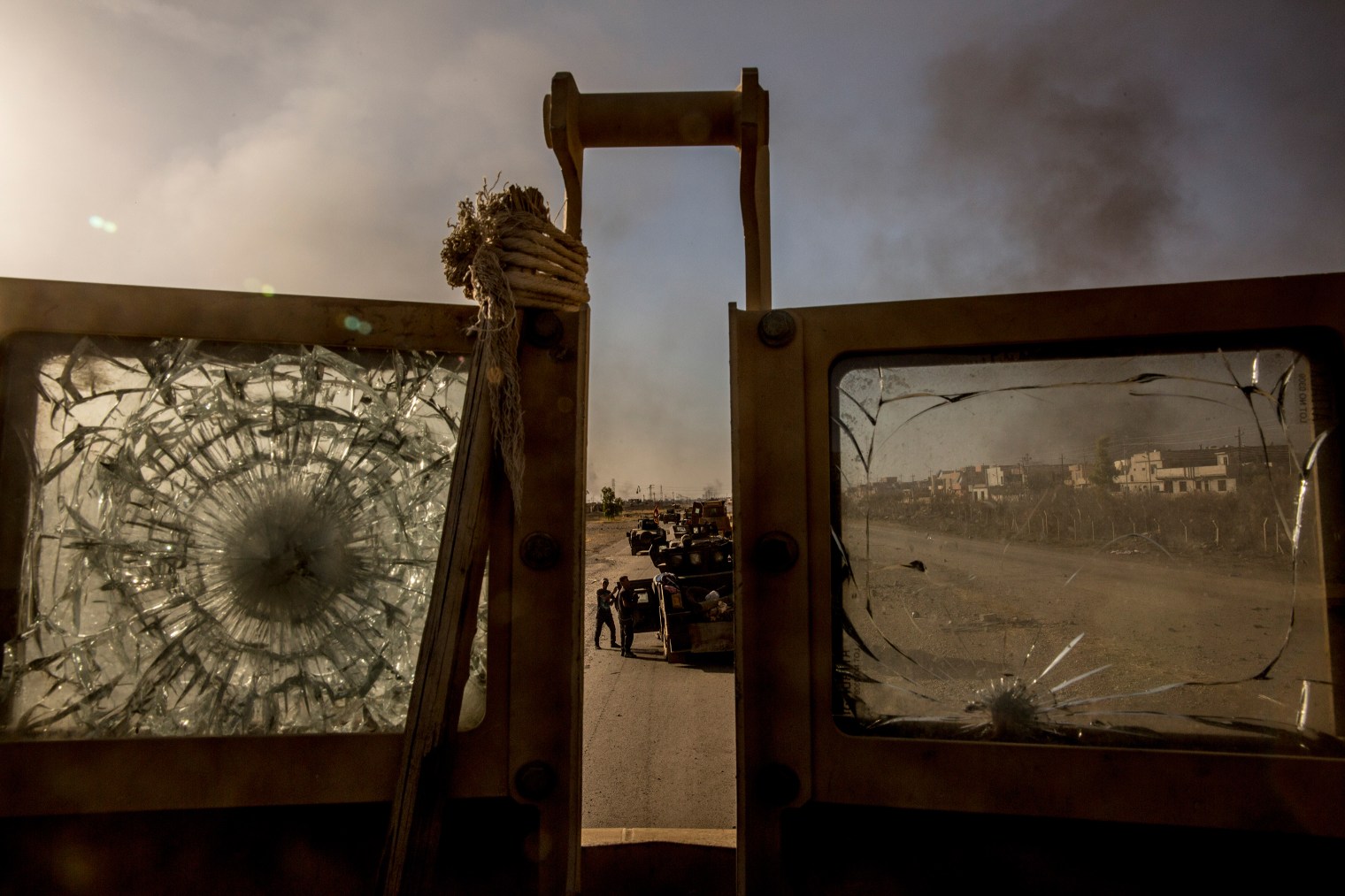 Bryan Denton—The New York Times/Redux
Bryan Denton—The New York Times/Redux
My time in Mosul was extremely brief. I never made it into the city limits because five days into the push—and on the first day the Iraqi Special Operations Forces launched their offensive, on Bartella, located to Mosul’s east—I was lightly wounded by a suicide car bomb. I took the following two and a half months to rest and recover.
The pictures that have stayed with me are the ones where you can get an idea of the extreme violence of the place, and the fear of that first day as Iraq’s forces began their push. We were pummeled with suicide car bombs. The convoy I was in was hit by four in the first five or six hours alone, including the one that wounded me in the end.
Combat, for me at least, has always seemed like a terrifying and lonely place. Any exhilaration only comes after, when you know it’s over. That day was steady, exhausting fear for everyone in the convoy. Our vehicles became less drivable as they were damaged by ISIS mortars and machine guns, and mobility equaled survival as we all—soldiers and journalists included—scanned nervously out the windows for rapidly approaching ISIS car bombs that seemed to appear out of nowhere.
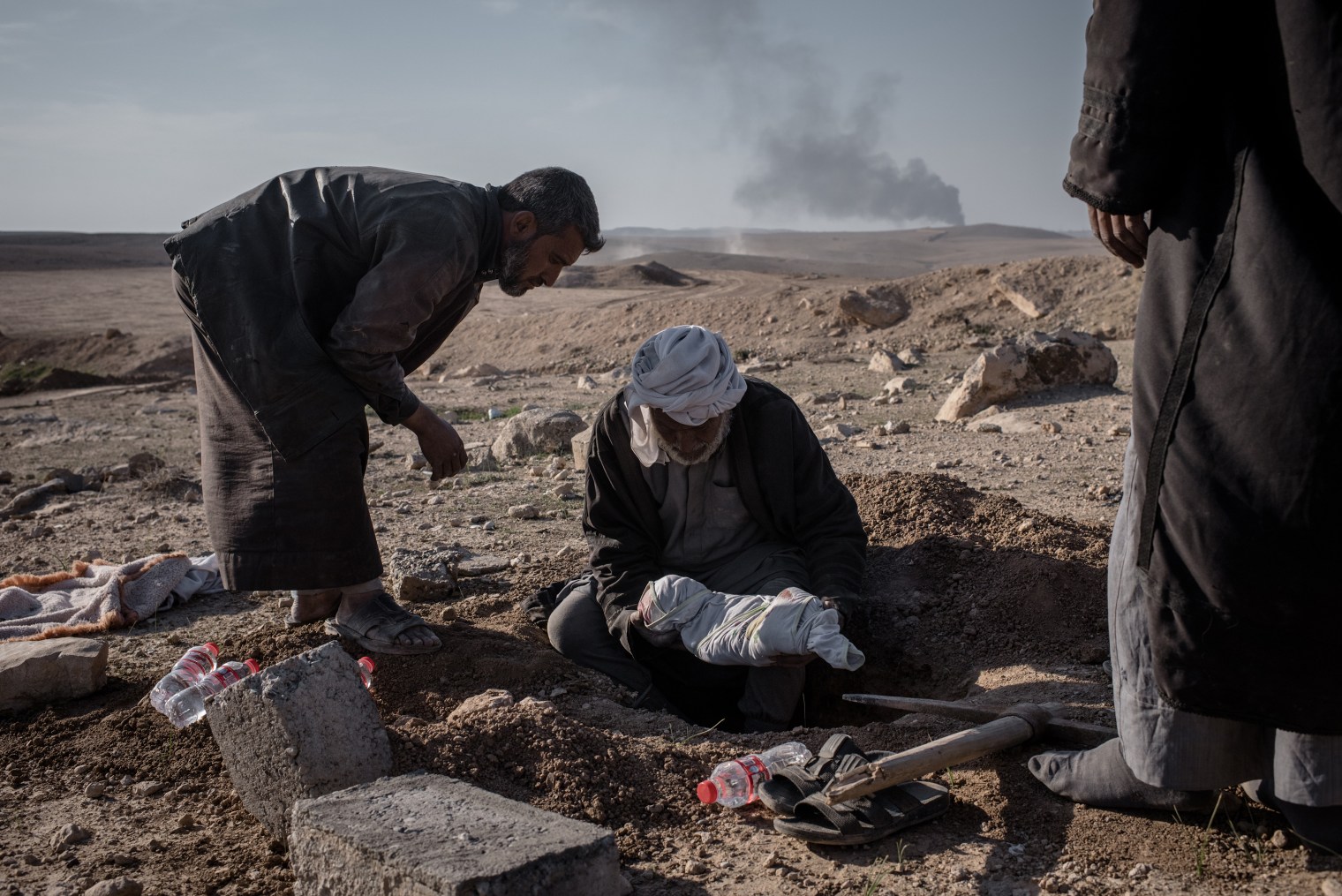 Cengiz Yar
Cengiz Yar
Out of the desert they walked, trudging through the sand and dust kicked up by Iraqi special forces Humvees. Some carried small bags of clothing. Others held sticks with white cloth tied to the end. Mohamed carried the tiny body of his two-month-old daughter wrapped in bloodied linen.
It was Feb. 23 on the southwest outskirts of Mosul, the day before Iraqi forces began their campaign to retake the western half of the city. Their attack prompted thousands of civilians like Mohamed and his family to flee. They had been sheltering inside that morning when some sort of munition hit their house. The explosion killed his wife, their infant and an unconfirmed number of other civilians nearby.
Security forces clustered Mohamed’s group together near a concrete home where his family sought out water. First they gulped desperately, then they washed the child’s body. Two women joined by the girl’s elderly uncle stripped the body in the shade behind the house. Holding the lifeless form by one leg, they poured water from plastic bottles over it.
No one spoke as the artillery and explosions echoed from the distance. I watched with a young Iraqi soldier, who looked at me and shook his head in sadness.
After re-wrapping the body in the linen, the girl’s uncle walked back out with a broken pickaxe and a shovel. He and other men from the family selected a small spot in the earth and began to dig. Tired and exhausted from their journey, and frail from the months of siege, they struggled to make a dent.
Each took turns before collapsing beside the hole in the earth. After digging for about 45 minutes they lowered the body. The flow of civilians passed by as smoke from the fighting rose behind them.
Stacking stones over the corpse, they then used water from the bottles to make clay with the earth and seal in the body. Kneeling, the men shoveled the remaining bits of dirt into the holes with their hands and placed a gravestone at the top. On it, along with the girl’s name and the year, was scratched: “This is a child’s grave.”
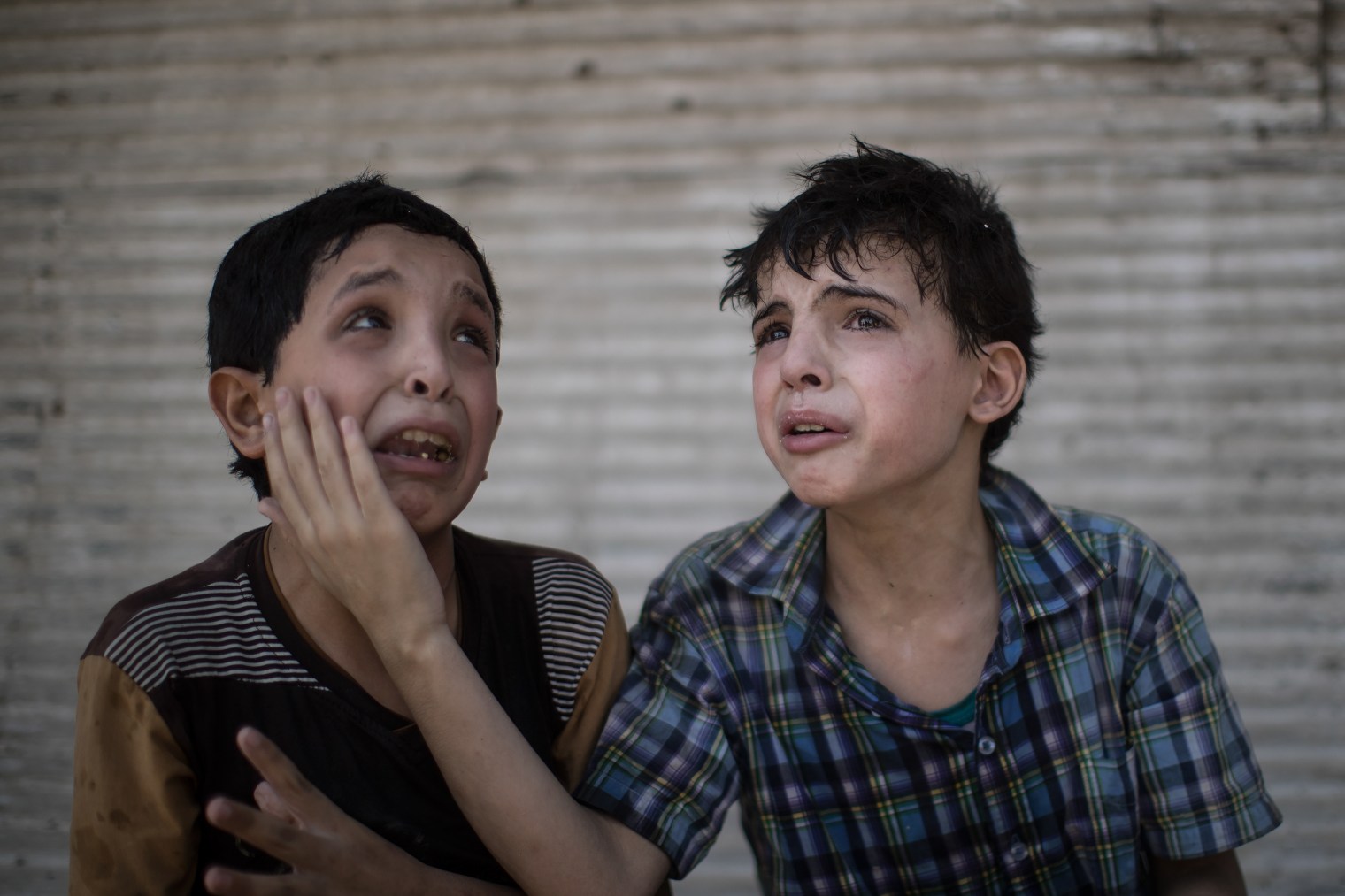 Felipe Dana—AP
Felipe Dana—AP
I was in a field hospital near the edge of the Old City, the last area of Mosul that was still controlled by Islamic State militants. The makeshift clinic was empty and it seemed like a calm day until we started hearing airstrikes and big explosions nearby. It didn’t take long until a group of civilians were rushed to the clinic.
I walked out and saw two boys sitting outside, crying and screaming desperately while volunteers and soldiers gave them water and some food. I sat down on the ground in front of them, trying to understand what was happening.
The two boys were cousins who had escaped after their house had been hit. They kept screaming, almost hysterically, that their parents were still under the rubble. Crying inconsolably, they were begging the soldiers and the medics to go and retrieve their parents but it was too dangerous to go there. I stayed with them for a while, taking pictures, even as more injured civilians kept arriving. Soon after I had to leave but I still wonder what happened to them and their families.
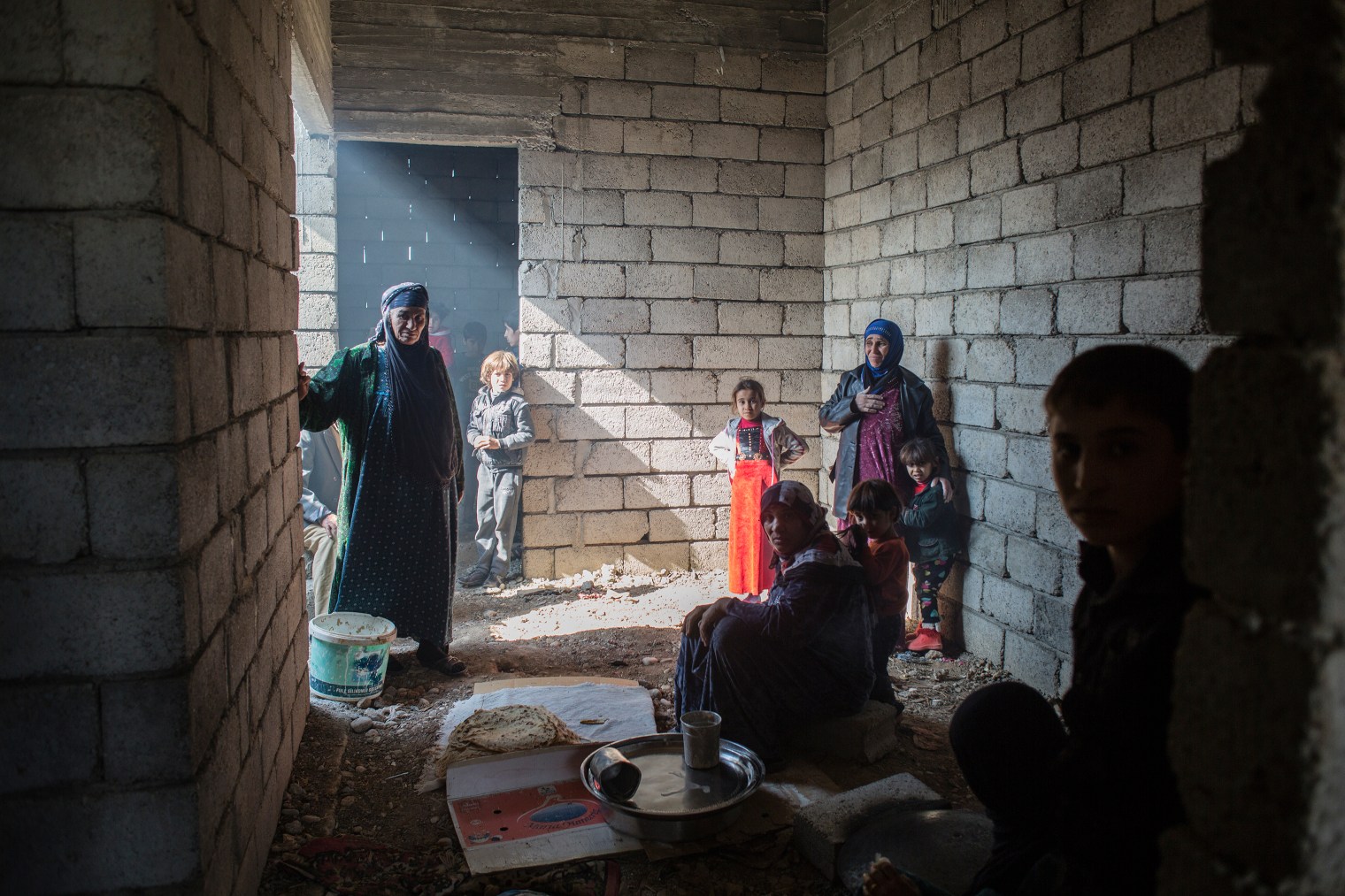 Hawre Khalid
Hawre Khalid
From the beginning of the Mosul offensive, I embedded with the Iraqi special forces “Golden Division” and stayed 20 days with them. Behind the front lines is more important to me because I believe I can see and understand more about war, outside of the fighting.
Every day I woke up with the sunrise, jumped into the Humvee and let my ears do more work than my eyes. One morning in November the Iraqi forces went on a raid, jumping from house to house, searching for ISIS members. At the end I entered this half-finished building in the eastern side with a commander to inspect it. I found myself in this silent room as the light came in. Nearby the soldiers and commander questioned people.
Hearing the men in the other room, at the same time as the silence of the people in this picture, sent me back to my childhood days. Saddam’s security forces entered our house almost every week just because we were Kurdish, asking us if we had any contact with the Peshmerga.
I stayed in this room for a while before I captured a picture. I was thinking maybe this is the first day they could make bread without thinking of death after three years living under ISIS. The lines of the cinder-block wall and the light where it comes in, and their scared faces, I drew a picture in my mind. I tried very hard to understand their feeling and what it’s like to live under ISIS. Now after being liberated, death is still very close to them. Photography to me is more about feeling than seeing. And then my finger moved and pressed the shutter.
I only took this picture. Suddenly the commander said, “let’s go, they are not ISIS.” We left the house but my mind will stay there forever.
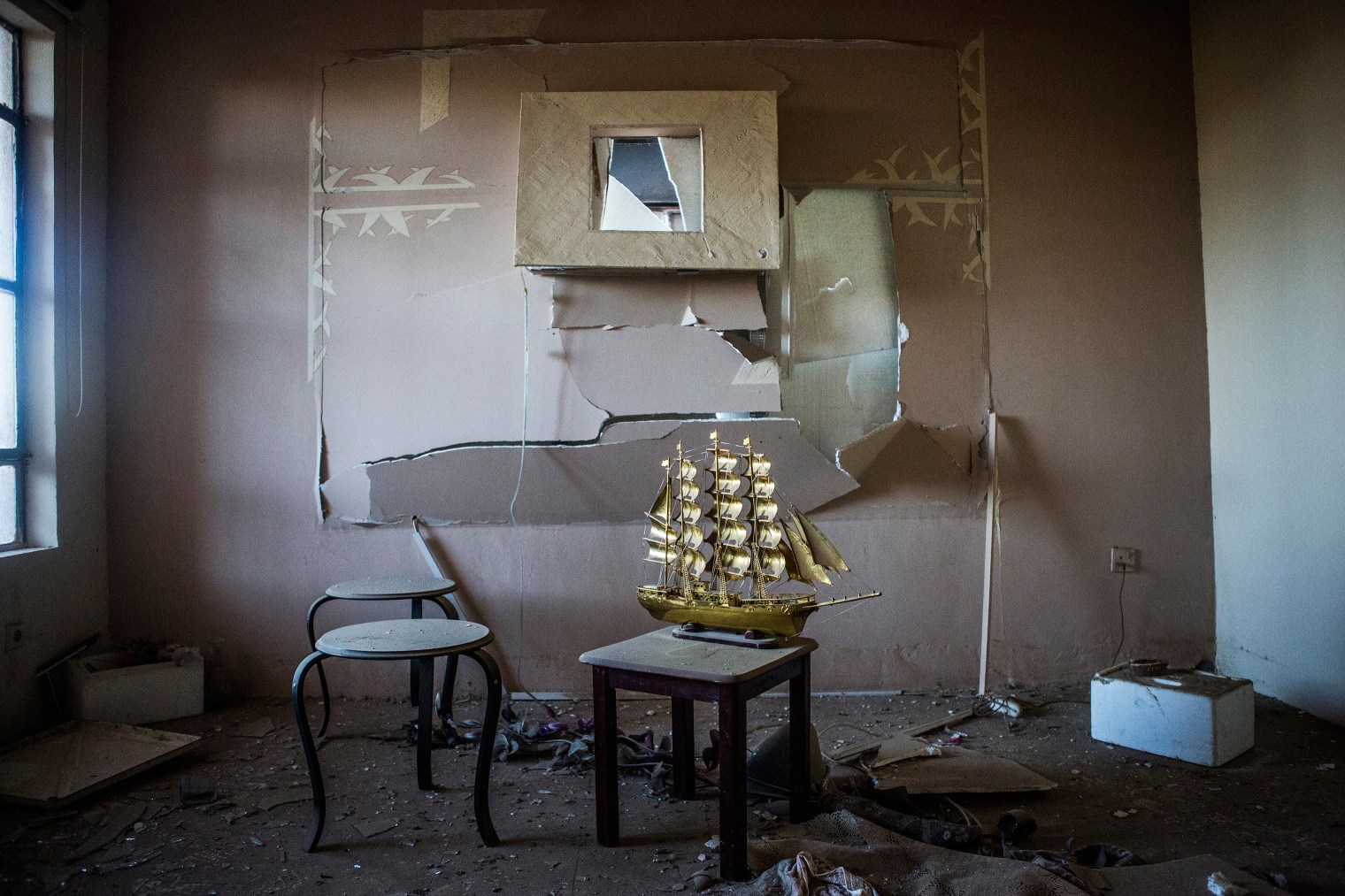 Alessio Mamo—Redux
Alessio Mamo—Redux
It was November and the city of Qaraqosh, Iraq’s largest Christian city about 30-km. from Mosul, had been liberated from ISIS. Most houses were looted or burned. I spent a week there with a group of photographers from Qaraqosh, displaced in Erbil, who were documenting the devastation of their city and their own houses.
We entered almost 500 houses destroyed by ISIS during the occupation. In each house there was a strong burn smell, and wherever I walked, broken pieces of glass and bricks under my boots. We were overwhelmed with tension because we could have encountered an unexploded mine or a fighter hidden inside the house.
Among the looted and burnt rooms, I found an unexpected object, where the light was concentrated in: a caravel left intact, and crumbles of the living room all around. This caravel gave me a strange sense of peace and the feeling that there is always a story to tell, a place where to return.
I had been looking for it a second time, wondering if the owners of this house went back there or not. Imagining that an element of their old life was waiting for them.
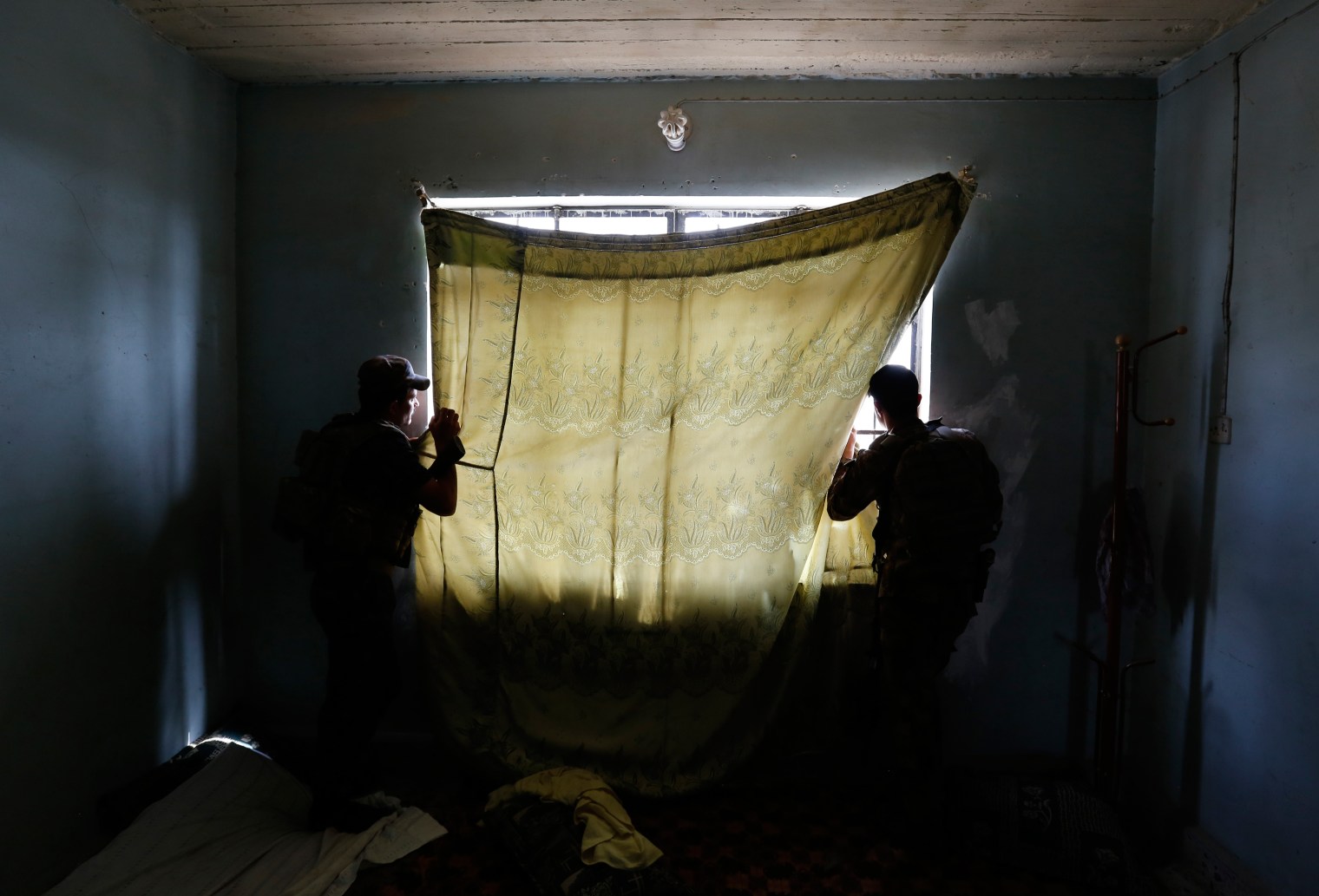 Danish Siddiqui—Reuters
Danish Siddiqui—Reuters
In May, I was accompanying a senior commander of the Counter Terrorism Service, an elite Iraqi security force trained by the U.S., during the battle to take control of western Mosul. We arrived at a small house on the frontline after walking through holes in the walls between homes. Islamic State snipers were firing a few hundred meters away.
The people who once lived there departed quickly, leaving clothes and toys scattered across the floor. The next inhabitants left hollow shell casings. The CTS had taken over the house a day earlier. The curtain was a bed sheet. They stood behind it to identify enemy snipers and watch one of their own.
It’s a quiet picture that tells of even the most uneventful of moments on the front, when nothing may happen and everything is possible.
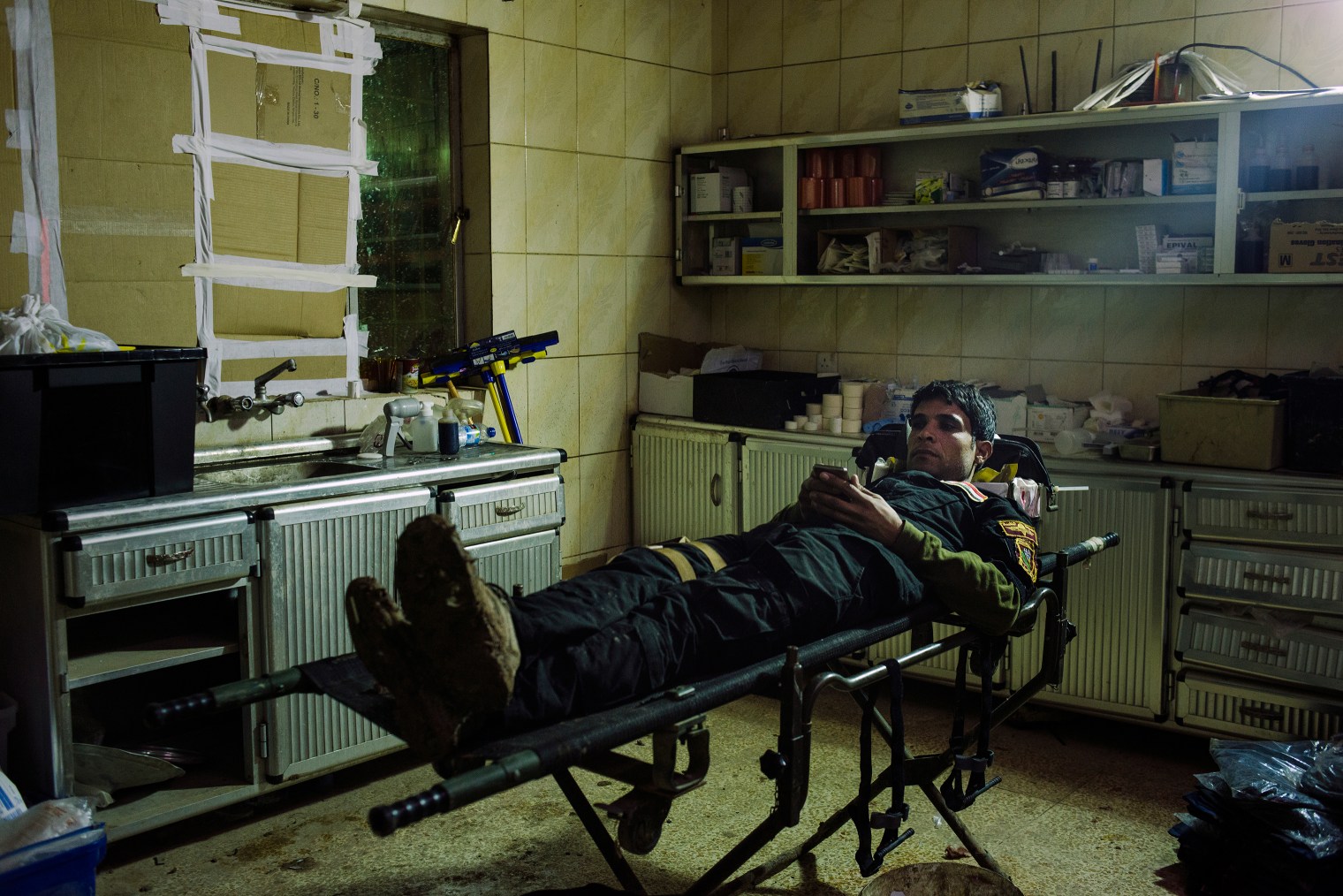 Alex Potter
Alex Potter
When I arrived in Iraq in November 2016, it wasn’t to cover the battle for Mosul. Overwhelmed with the number of journalists in-country, and with a new project off to a bumpy start, I thought of another way I could be useful.
In addition to photojournalist, I’m a registered nurse and have always been interested in trauma and emergency care. I found an NGO working alongside Iraqi medics doing pre-hospital care near the front lines during the battle. Working side-by-side in the worst of circumstances, I got to know and came to care deeply for the Iraqi medics like Ahmad, pictured here scrolling through Facebook on his phone, on a bed usually used to treat trauma patients. While they wouldn’t ever talk about it, I could see how losing their friends and comrades affected them.
Ahmad, usually a jokester, went through bouts of quiet during the worst days. December was a month for lots of casualties; we routinely saw 50-75 trauma patients a day and I figured he had lost a friend. Usually people in that bed are screaming in pain or silent and about to die, so to have him laying there was a heavy moment.
Mosul might be over, but these men will continue caring for their military friends as well as civilians when the next battle begins, whatever comes after ISIS.
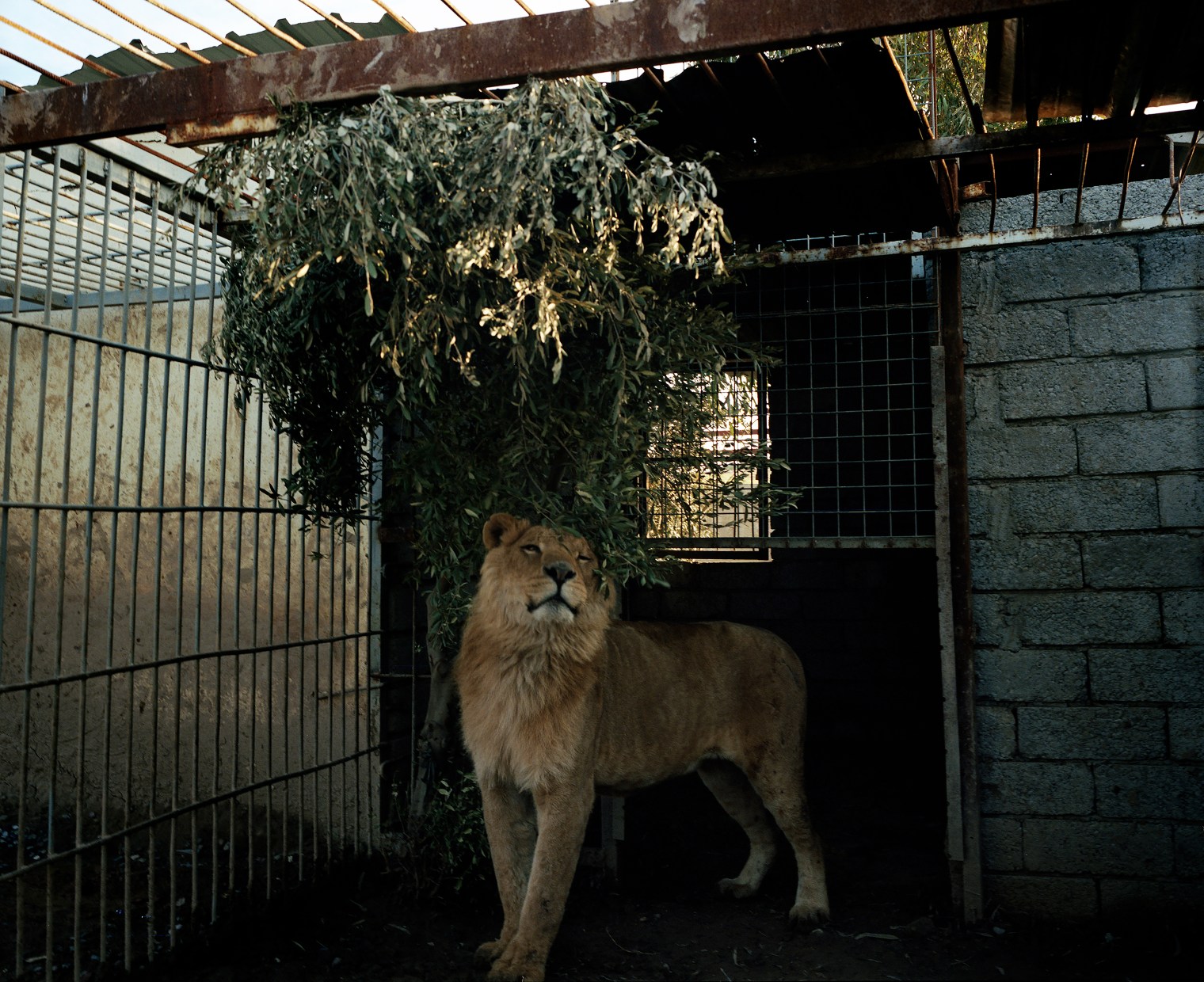 Loulou d’Aki—Agence VU
Loulou d’Aki—Agence VU
We went to visit the Mosul zoo one afternoon in March. It was closed but we found the caretaker who opened up the gates to a smaller area with a row of large cages. The zoo had been abandoned after ISIS took control of the city and we were told that most animals had starved to death. What remained now was a lion named Simba and a bear named Lula; they were both invisible to us at first as they stayed in the shade, in the back of their cages.
The caretaker then brought out a piece of meat on a stick for the lion and some yellow apples for the bear. Men and children gathered around us as the two animals appeared and we started photographing. This was back at a time when life was slowly returning to some sort of normalcy, accompanied by the sound of gunshots and intercepted suicide vehicles in the east and against a backdrop of destruction.
In ancient Mesopotamia, the lion was regarded as a symbol of kingship. Seeing it here like this, the lion became for me yet another symbol of what the country had been but was no more. All through my stay in Iraq, the feeling of past greatness and current decline was something I couldn’t shake.
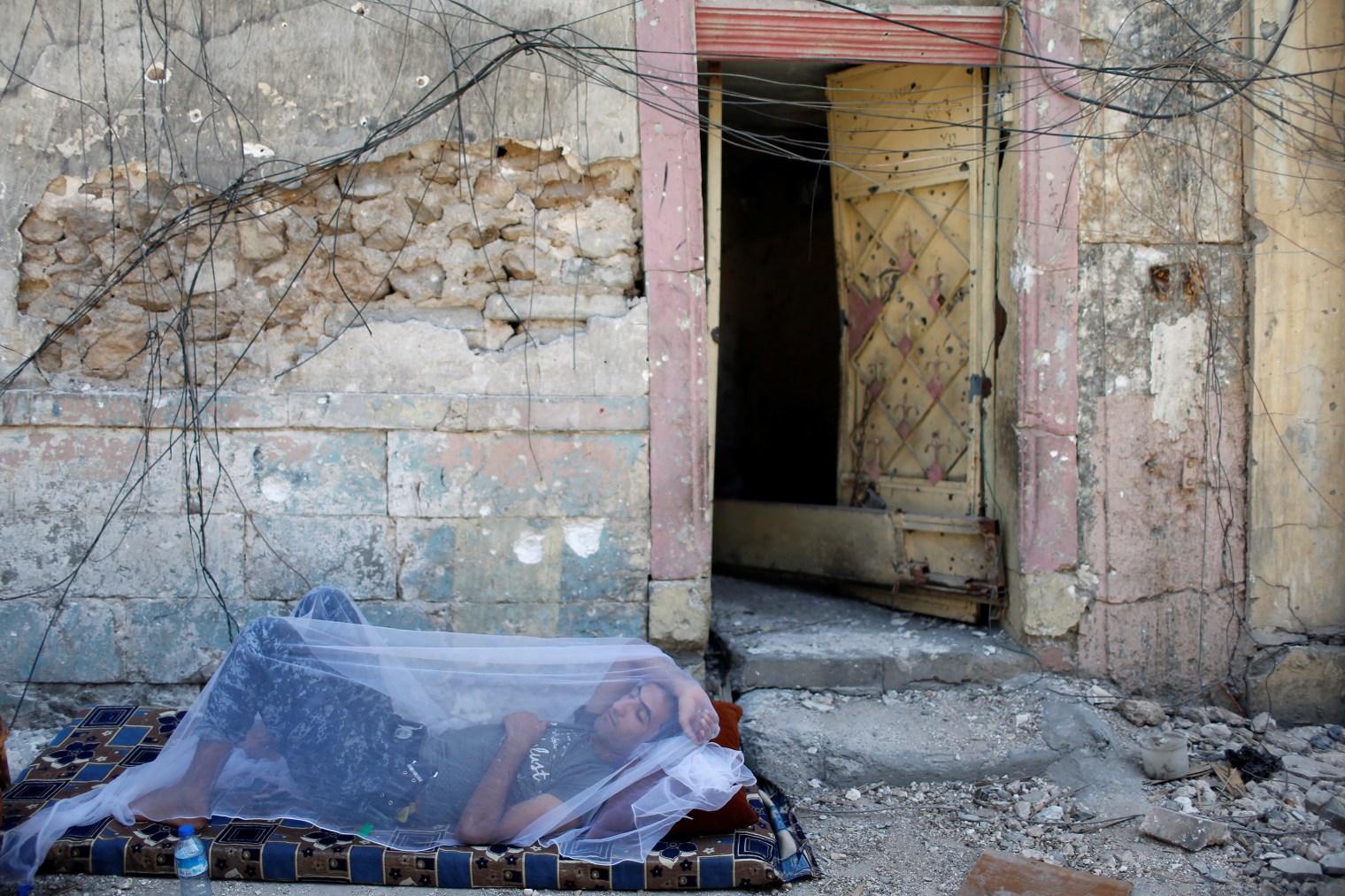 Ahmed Jadallah—Reuters
Ahmed Jadallah—Reuters
I left Erbil early in the morning, bound for Mosul with our multimedia team and security adviser in an armored car. After an almost three-hour drive, passing many Kurdish Peshmerga and Iraqi military checkpoints, we crossed the Tigris River and reached the headquarters of the Iraqi Federal Police in western Mosul.
An hour later a convoy escorted us to the frontline in the Old City. There, while covering a battle between Federal Police and Islamic State militants, I passed the soldier in this photograph. He was taking a rest in a temporarily more sheltered spot and draped himself with a net to keep away clouds of insects that had been attracted by dead bodies and raw sewage nearby.
The picture shows the rough conditions of the frontline, where there is no decent place to sleep while the fighting carries on. Just one mistake of walking down a street in the wrong direction could have landed me in the deadly hands of ISIS.
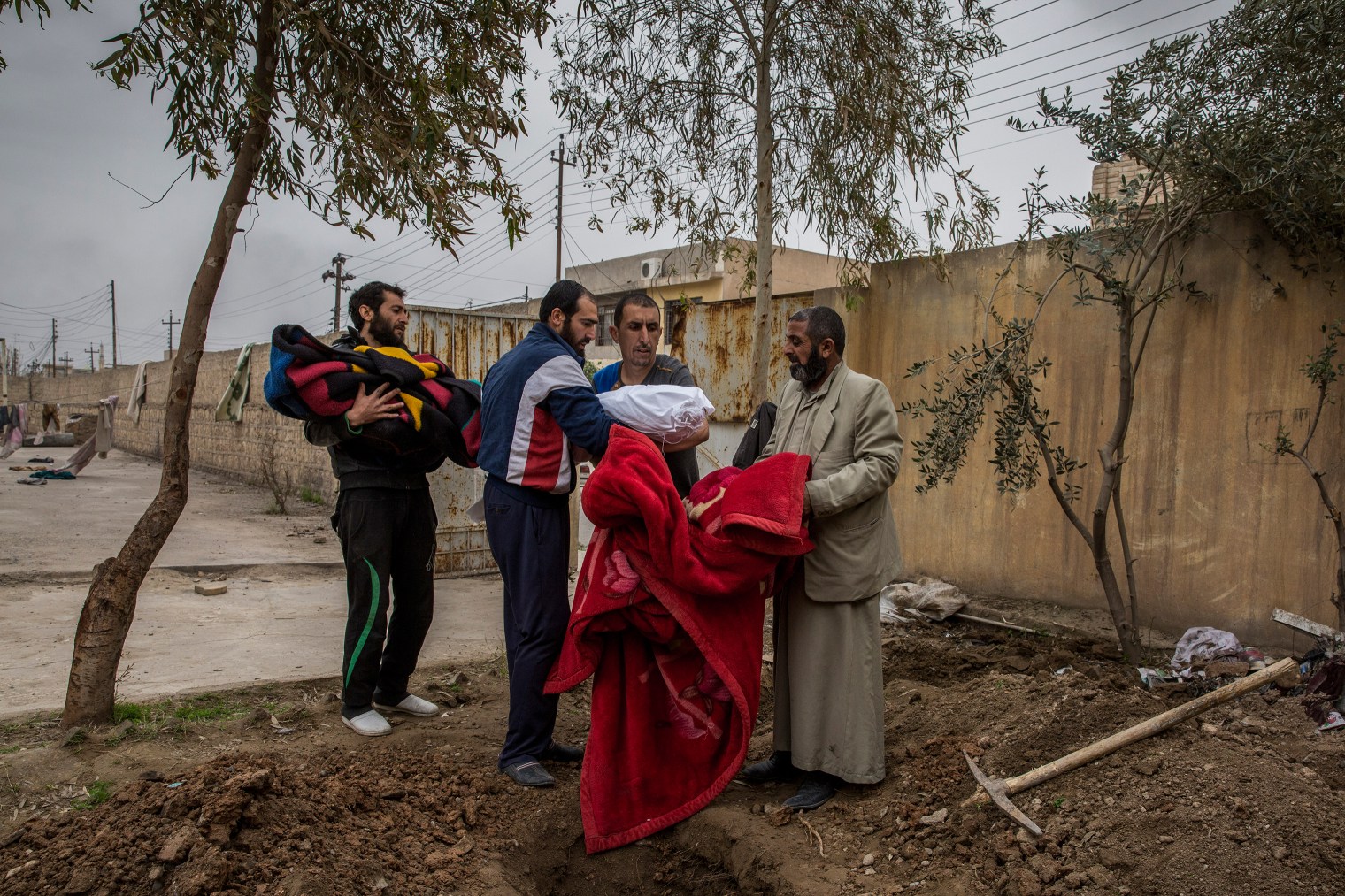 Ivor Prickett—The New York Times/Redux
Ivor Prickett—The New York Times/Redux
I took this picture at the end of March, when Iraqi forces were battling Islamic State militants in the western neighborhood of Mosul Jidideh. It was a particularly brutal chapter in the long fight to retake Mosul from ISIS and the amount of firepower being rained down on this sprawling residential area was immense. Civilian casualties as a result of bombardment from Iraqi forces and coalition air support were on the rise.
As I photographed a group of civilians fleeing from the frontline, I realized some of the men in the group were carrying two small bodies wrapped in blankets. Five-year-old Mohammed Hamed and his four-year-old sister Amina had died from injuries sustained during an airstrike targeting militants hiding in the house next door to theirs. Friends and family members buried their bodies in one shallow grave in a schoolyard before fleeing the city for the safety of the camps.
I watched as they struggled to dig a hole big enough in the dry, rocky earth while airstrikes continued to rain down nearby. It was one of saddest moments I have witnessed over the last eight months covering the battle for Mosul, and one that stayed with me for a long time after. It was one thing for the family to lose their children, but the fact that they had to leave them behind in a hastily dug grave without a proper farewell seemed so unfair and difficult to accept. In a way I felt incapable of truly conveying how heartbreaking the scene was.
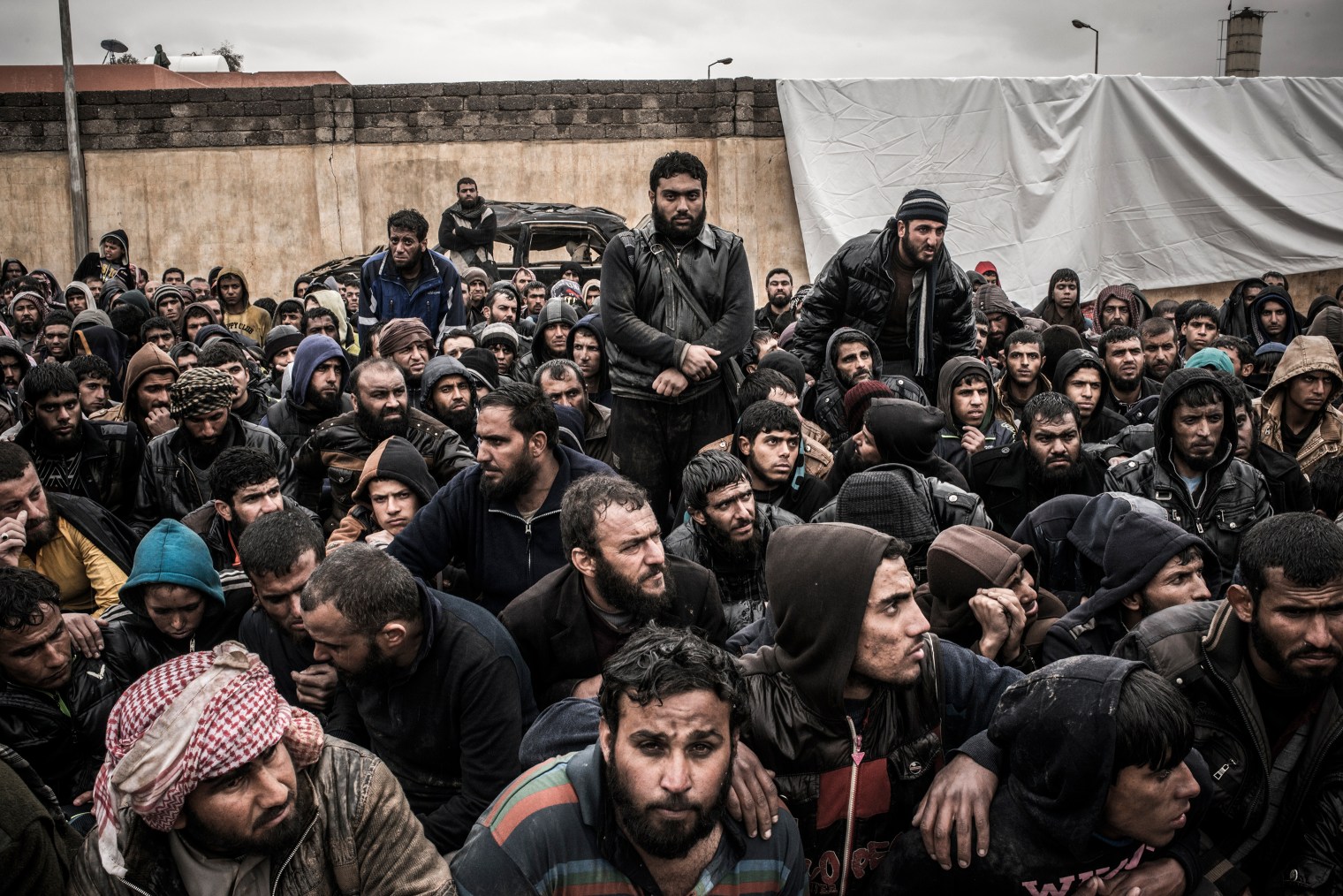 Martyn Aim
Martyn Aim
In March, Iraqi men who had fled fighting in western Mosul were separated from their families to be registered. Their IDs were checked on an intelligence database to determine whether they were Islamic State fighters or supporters. The men had walked a long way. It was winter, cold and wet. Many had lost their shoes in the mud and were barefoot. Some collapsed from exposure.
I said “hello” to some and they replied warmly, shaking their heads as if to say: “and after all this suffering now we have to go through this.” Some glared straight at me, through me. A few, I felt certain, were fighters—at least at the time. Some were taken from the crowd by Iraqi military intelligence officers who led them away for interrogation and sometimes punched and slapped them out of the sight of the others. Some were then released, brought back to the crowd of men to eventually join their families in a camp. Once their identity and innocence was determined, they were treated kindly by the soldiers.
In recent weeks, as Iraqi forces approached the end of the battle, the belief held was that any man coming out of the couple of hundred square meters of the Old City district was almost certainly ISIS.
There are executions. Looking at the faces of these men, that’s what I think of. This part of the war is not written about. Nobody knows how many have been killed like this. Islamic State atrocities are horrific, incomprehensible. Morality shifts when facing an enemy like ISIS. It’s pointless to pretend otherwise.
A few days ago another photographer and I saw two men led out of our sight down an alley amidst the rubble. We heard two cracks of gunfire and the soldiers returned. One lifted his hand to us and shook his head. He was not ashamed; he was proud. The soldiers have lost family, friends, brother soldiers. It is impossible for most of us to understand how much they have endured. Who can judge them? I can’t.
But in the end there is the question: perhaps they made a mistake, how do they know that man was really with Islamic State? Were they certain? That’s what I see when I look at the men in my photograph: which of them were Islamic State fighters—which of them have killed, tortured, raped—and which are just civilians who have been trapped and tried against horrific odds to keep their families alive, to keep them safe. I can’t tell when I look at their faces.
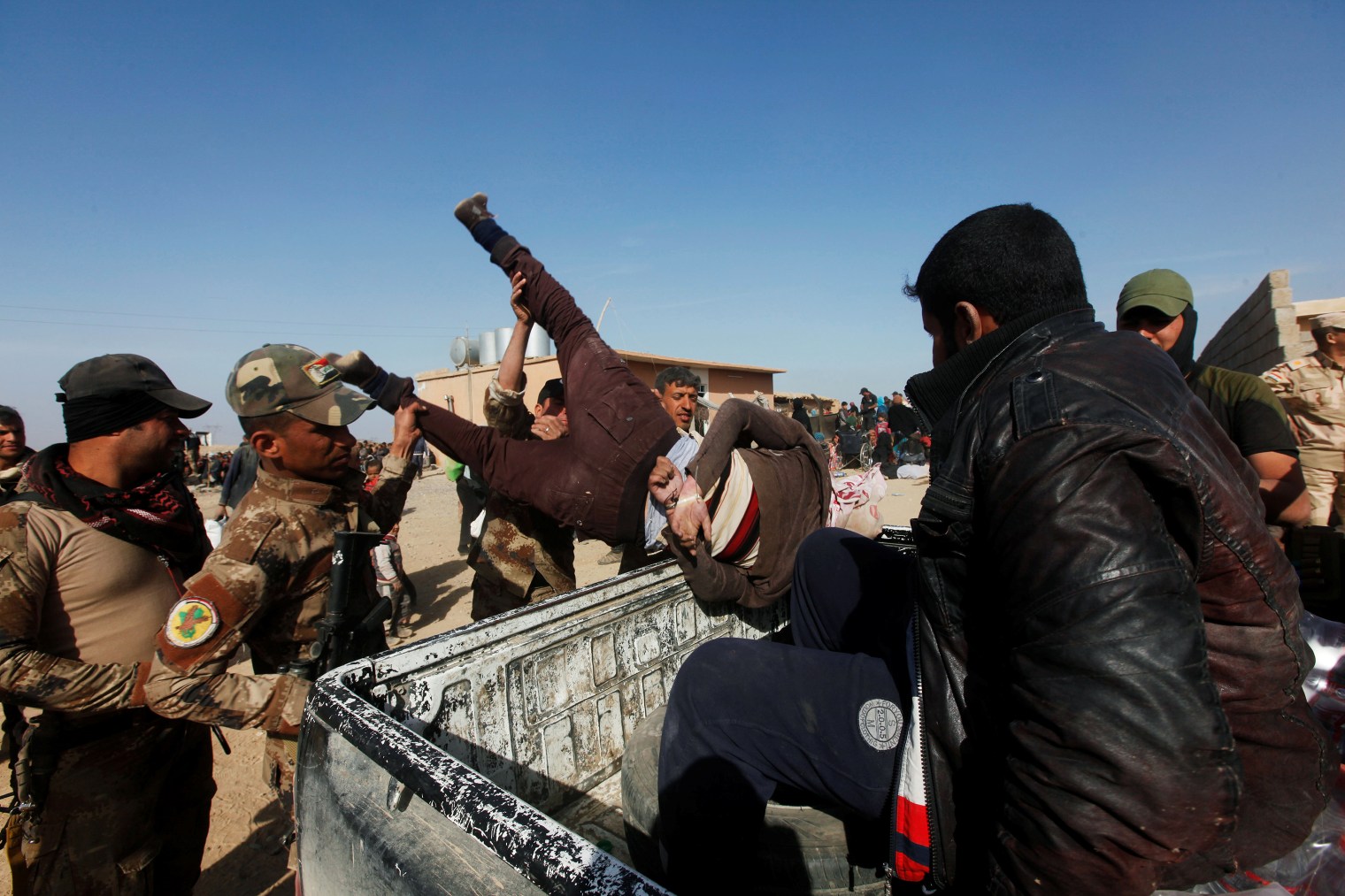 Alaa Al-Marjani—Reuters
Alaa Al-Marjani—Reuters
It was on Feb. 26 when I spotted four suspected Islamic State militants who were picked out of a group of displaced people by Iraqi soldiers. The suspects had been identified by civilians who worked with the security forces and wore masks to protect themselves from possible reprisal. The suspects, including the man in this picture, were then tossed into the bed of a pickup truck.
My picture was significant for our story because it helped illustrate how some militants had hidden themselves among fleeing civilians in hopes of evading capture. Some trimmed their bushy beards and changed their clothes in efforts to blend in.
I had been covering developments on another front when I saw on social media that a large group of refugees was heading to this location. Not much was happening where I was so I changed cars and headed to the refugee gathering point. The way the suspects were being treated was abnormal.
After I took this picture, a military intelligence officer tried to seize my camera and send me away. I was working with a Reuters correspondent and security adviser, so the officer eventually backed off.
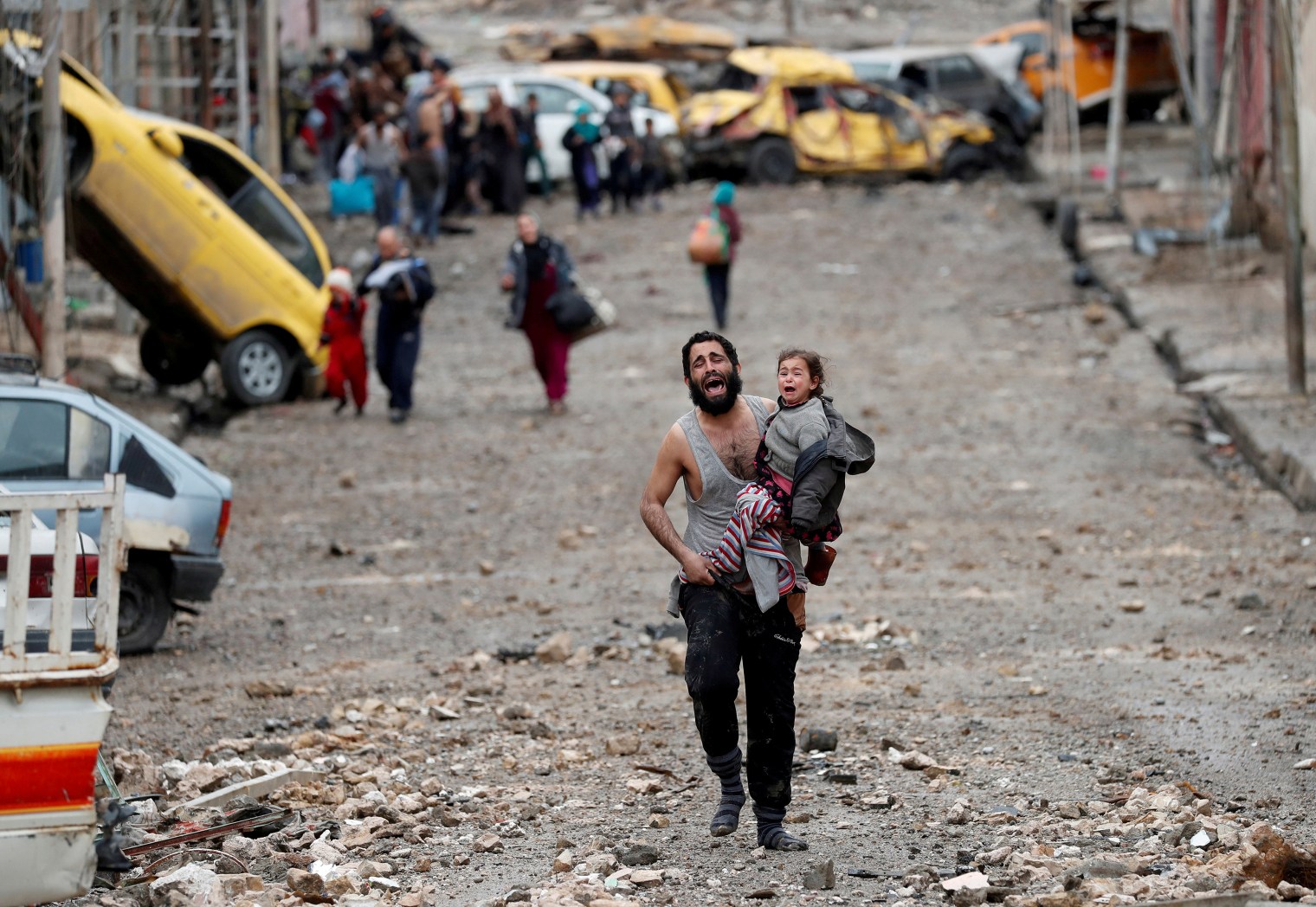 Goran Tomasevic—Reuters
Goran Tomasevic—Reuters
Both screaming in terror, the father and the young daughter he cradled in his arm fled through the rubble-strewn streets of Wadi Hajar, transformed in a flash into a battleground between Islamic State fighters and Iraqi special forces.
They and their neighbors—some wearing rubber sandals, some barefoot—were running from an ISIS counterattack in this part of southwest Mosul, dodging gunfire as the militants closed in. When they reached the special forces lines, males were ordered to lift their shirts to prove they weren’t suicide bombers.
It’s become a common tactic for the militants to use suicide bombers. The soldiers fired their guns in the air to try to slow the residents down, shouting at them. Civilians had been displaced in greater numbers in recent days, as the fighting in and around Islamic State’s last strongholds in Mosul rages in neighborhoods where water, food and power have been rationed for months.
The father was so beside himself, so panicked. I believe they were both taken to a refugee camp.
July 17, 2017